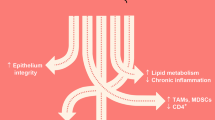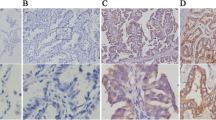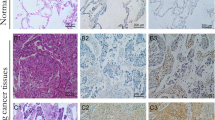Abstract
Background: Ligands for CXCR3 chemokines [IFN-γ-inducible protein of 10 kD (IP-10/CXCL10), monokine induced by IFN-γ (Mig/CXCL9), IFN-inducible T cell α chemoattractant (I-TAC/CXCL11)] and those for CCR4 [macrophage-derived chemokine (MDC/CCL22), thymus- and activation-regulated chemokine (TARC/CCL17)] have been shown to play the central roles for T helper-cell recruitment into the tissues. To examine the role of these chemokines in tumor progression of lung cancer, we investigated their expression in human lung cancer tissues to determine the possible relationship between their expression and the prognosis of patients. Methods: Total RNA was prepared from lung cancer tissues of 40 patients (24 adenocarcinoma and 16 squamous cell carcinoma). We measured gene expression levels of chemokines (IP-10, Mig, I-TAC, MDC and TARC) by real-time quantitative RT-PCR. Results: Higher gene expression of MDC in lung cancer was significantly correlated with longer disease-free survival time and lower risk of recurrence after tumor resection. We could not find any significant relationship of IP-10, Mig, I-TAC and TARC gene expression with disease-free survival or lower risk of recurrence after surgery. Conclusions: These results suggest that increased gene expression of MDC in tumor tissues may be a predictive marker for improving the prognosis of lung cancer.







Similar content being viewed by others
Abbreviations
- MDC:
-
Macrophage-derived chemokine
- IP-10:
-
Interferon-inducible protein of 10 kD
- Mig:
-
Monokine induced by interferon-gamma
- I-TAC:
-
Interferon-inducible T cell α chemoattractant
- TARC:
-
Thymus- and activation-regulated chemokine
- RT-PCR:
-
Reverse transcription-polymerase chain reaction
- TNF-α:
-
Tumor necrosis factor-α
- IFN-γ:
-
Interferon γ
- GAPDH:
-
Glyceraldehyde-3-phosphate dehydrogenase
References
Winterhalder RC, Hirsch FR, Kotantoulas GK, Franklin WA, Bunn PA Jr (2004) Chemoprevention of lung cancer—from biology to clinical reality. Ann Oncol 15:185–196
Rea F, Marulli G, Callegaro D, Zuin A, Gobbi T, Loy M, Sartori F (2004) Prognostic significance of main bronchial lymph nodes involvement in non-small cell lung carcinoma: N1 or N2? Lung Cancer 45:215–220
Frederick MJ, Clayman GL (2001) Chemokines in cancer. Expert Rev Mol Med 2001:1–18
Arya M, Patel HRH, Williamson M (2003) Chemokines: key players in cancer. Curr Med Res Opin 19:557–564
Van Damme J, Struyf S, Opdenakker G (2004) Chemokine-protease interactions in cancer. Semin Cancer Biol 14:201–208
Opdennakker G, van Damme J (2004) The countercurrent principle in invasion and metastasis of cancer cells. recent insights on the roles of chemokines. Int J Dev Biol 48:519–527
D’Ambrosio D, Mariani M, Panina-Bordignon P, Sinigaglia F (2001) Chemokines and their receptors guiding T lymphocyte recruitment in lung inflammation. Am J Respir Crit Care Med 164:1266–1275
Sauty A, Dziejman M, Taha RA, Iarossi AS, Neote K, Garcia-Zepeda EA, Hamid Q, Luster AD (1999) The T cell-specific CXC chemokines IP-10, Mig, and I-TAC are expressed by activated human bronchial epithelial cells. J Immunol 162:3549–3558
Qiu B, Frait KA, Reich F, Komuniecki E, Chensue SW (2001) Chemokine expression dynamics in mycobacterial (type-1) and schistosomal (type-2) antigen-elicited pulmonary granuloma formation. Am J Pathol 158:1503–1515
Carlo ED, Cappello P, Sorrentino C, D’Antuono T, Pellicciotta A, Giovarelli M, Forni G, Musiani P, Triebel F (2005) Immunological mechanisms elicited at the tumour site by lymphocyte activation gene-3 (LAG-3) versus IL-12: sharing a common Th1 anti-tumour immune pathway. J Pathol 205:82–91
Sekiya T, Miyamasu M, Imanishi M, Yamada H, Nakajima T, Yamaguchi M, Fujisawa T, Pawankar R, Sano Y, Ohta K, Ishii A, Morita Y, Yamamoto K, Matsushima K, Yoshie O, Hirai K (2000) Inducible expression of a Th2-type CC chemokine thymus- and activation-regulated chemokine by human bronchial epithelial cells. J Immunol 165:2205–2213
Ikeda H, Chamoto K, Tsuji T, Suzuki Y, Wakita D, Takeshima T, Nishimura T (2004) The critical role of type-1 innate and acquired immunity in tumor immunotherapy. Cancer Sci 95:697–703
Noguchi M, Imaizumi K, Kawabe T, Wakayama H, Horio Y, Sekido Y, Hara T, Hashimoto N, Takahashi M, Shimokata K, Hasegawa Y, (2001) Induction of antitumor immunity by transduction of CD40 ligand gene and interferon-gamma gene into lung cancer. Cancer Gene Ther 8:421–429
White ES, Flaherty KR, Carskadon S, Brant A, Iannettoni MD, Yee J, Orringer MB, Arenberg DA (2003) Macrophage migration inhibitory factor and CXC chemokine expression in non-small cell lung cancer: role in angiogenesis and prognosis. Clin Cancer Res 9:853–860
Monti P, Leone BE, Marchesi F, Balzano G, Zerbi A, Scaltrini F, Pasquali C, Calori G, Pessi F, Sperti C, Di Carlo V, Allavena P, Piemonti L (2003) The CC chemokine MCP-1/CCL2 in pancreatic cancer progression: regulation of expression and potential mechanisms of antimalignant activity. Cancer Res 63:7451–7461
Burger M, Glodek A, Hartmann T, Schmitt-Graff A, Silberstein LE, Fujii N, Kipps TJ, Burger JA (2003) Functional expression of CXCR4 (CD184) on small-cell lung cancer cells mediates migration, integrin activation, and adhesion to stromal cells. Oncogene 22:8093–8101
Tepper RI, Pattengale PK, Leder P (1989) Murine interleukin-4 displays potent anti-tumor activity in vivo. Cell 57:503–512
Nagai S, Toi M (2000) Interleukin-4 and breast cancer. Breast Cancer 7:181–186
Guo J, Wang B, Zhang M, Chen T, Yu Y, Regulier E, Homann HE, Qin Z, Ju DW, Cao X (2002) Macrophage-derived chemokine gene transfer results in tumor regression in murine lung carcinoma model through efficient induction of antitumor immunity. Gene Ther 9:793–803
Lee JM, Merritt RE, Mahtabifard A, Yamada R, Kikuchi T, Crystal RG, Korst RJ (2003) Intratumoral expression of macrophage-derived chemokine induces CD4+ T cell-independent antitumor immunity in mice. J Immunother 26:117–129
Ghia P, Transidico P, Veiga JP, Schaniel C, Sallusto F, Matsushima K, Sallan SE, Rolink AG, Mantovani A, Nadler LM, Cardoso AA (2001) Chemoattractants MDC and TARC are secreted by malignant B-cell precursors following CD40 ligation and support the migration of leukemia-specific T cells. Blood 98:533–540
Marx J (2004) Inflammation and cancer: the link grows stronger. Science 306:966–968
Lin EY, Nguyen AV, Russell GR, Pollard JW (2001) Colony-stimulating factor 1 promotes progression of mammary tumors to malignancy. J Exp Med 193:727–740
Daniel D, Meyer-Morse N, Bergsland EK, Dehne K, Coussens LM, Hanahan D (2003) Immune enhancement of skin carcinogenesis by CD4+ T cells. J Exp Med 197:1017–1028
Arenberg DA, Kunkel SL, Polverini PJ, Morris SB, Burdick MD, Glass MC, Taub DT, Iannettoni MD, Whyte RI, Strieter RM (1996) Interferon-gamma-inducible protein 10 (IP-10) is an angiostatic factor that inhibits human non-small cell lung cancer (NSCLC) tumorigenesis and spontaneous metastases. J Exp Med 184:981–992
Kondo T, Ito F, Nakazawa H, Horita S, Osaka Y, Toma H (2004) High expression of chemokine gene as a favorable prognostic factor in renal cell carcinoma.. J Urol 171:2171–2175
Okada N, Gao JQ, Sasaki A, Niwa M, Okada Y, Nakayama T, Yoshie O, Mizuguchi H, Hayakawa T, Fujita T, Yamamoto A, Tsutsumi Y, Mayumi T, Nakagawa S (2004) Anti-tumor activity of chemokine is affected by both kinds of tumors and the activation state of the host’s immune system: implications for chemokine-based cancer immunotherapy. Biochem Biophys Res Commun 317:68–76
Berin MC, Eckmann L, Broide DH, Kagnoff MF (2001) Regulated production of the T helper 2-type T-cell chemoattractant TARC by human bronchial epithelial cells in vitro and in human lung xenografts. Am J Respir Cell Mol Biol 24:382–389
Curiel TJ, Coukos G, Zou L, Alvarez X, Cheng P, Mottram P, Evdemon-Hogan M, Conejo-Garcia JR, Zhang L, Burow M, Zhu Y, Wei S, Kryczek I, Daniel B, Gordon A, Myers L (2004) Specific recruitment of regulatory T cells in ovarian carcinoma fosters immune privilege and predicts reduced survival. Nat Med 10:942–949
Arriagada R, Bergman B, Dunant A, Le Chevalier T, Pignon JP, Vansteenkiste J (2004) Cisplatin-based adjuvant chemotherapy in patients with completely resected non-small-cell lung cancer. N Engl J Med 350:351–360
Kato H, Ichinose Y, Ohta M, Hata E, Tsubota N, Tada H, Watanabe Y, Wada H, Tsuboi M, Hamajima N (2004) A randomized trial of adjuvant chemotherapy with uracil-tegafur for adenocarcinoma of the lung. N Engl J Med 350:1713–1721
Acknowledgements
The authors thank Ms. Ayako Asai, Emi Kusama, Hiromi Isejima and Keiko Shimamoto for their continuous technical assistance. This work was supported in part by a Grant-in-Aid for the 21st Century COE Program “Integrated Molecular Medicine for Neuronal and Neoplastic Disorders” from the Ministry of Education, Culture, Sports, Science and Technology and a Grant-in-Aid for the Scientific Research from the Japan Society for the Promotion of Science.
Author information
Authors and Affiliations
Corresponding author
Additional information
Toru Nakanishi and Kazuyoshi Imaizumi equally contributed to this work.
Rights and permissions
About this article
Cite this article
Nakanishi, T., Imaizumi, K., Hasegawa, Y. et al. Expression of macrophage-derived chemokine (MDC)/CCL22 in human lung cancer. Cancer Immunol Immunother 55, 1320–1329 (2006). https://doi.org/10.1007/s00262-006-0133-y
Received:
Accepted:
Published:
Issue Date:
DOI: https://doi.org/10.1007/s00262-006-0133-y




